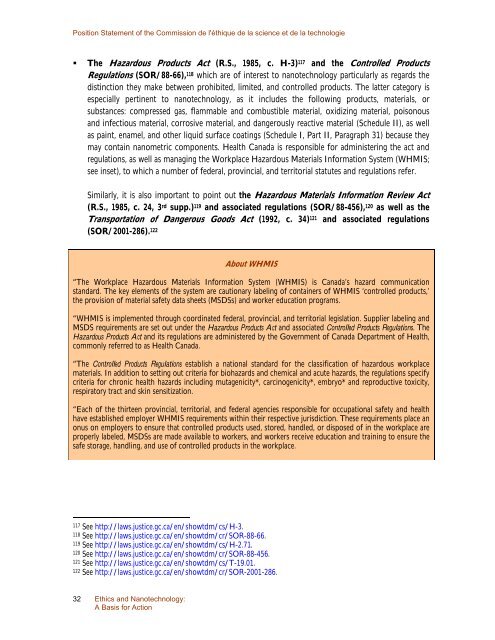A Basis for Action - Commission de l'éthique de la science et de la ...
A Basis for Action - Commission de l'éthique de la science et de la ...
A Basis for Action - Commission de l'éthique de la science et de la ...
You also want an ePaper? Increase the reach of your titles
YUMPU automatically turns print PDFs into web optimized ePapers that Google loves.
Position Statement of the <strong>Commission</strong> <strong>de</strong> l'éthique <strong>de</strong> <strong>la</strong> <strong>science</strong> <strong>et</strong> <strong>de</strong> <strong>la</strong> technologie<br />
• The Hazardous Products Act (R.S., 1985, c. H-3) 117 and the Controlled Products<br />
Regu<strong>la</strong>tions (SOR/88-66), 118 which are of interest to nanotechnology particu<strong>la</strong>rly as regards the<br />
distinction they make b<strong>et</strong>ween prohibited, limited, and controlled products. The <strong>la</strong>tter category is<br />
especially pertinent to nanotechnology, as it inclu<strong>de</strong>s the following products, materials, or<br />
substances: compressed gas, f<strong>la</strong>mmable and combustible material, oxidizing material, poisonous<br />
and infectious material, corrosive material, and dangerously reactive material (Schedule II), as well<br />
as paint, enamel, and other liquid surface coatings (Schedule I, Part II, Paragraph 31) because they<br />
may contain nanom<strong>et</strong>ric components. Health Canada is responsible <strong>for</strong> administering the act and<br />
regu<strong>la</strong>tions, as well as managing the Workp<strong>la</strong>ce Hazardous Materials In<strong>for</strong>mation System (WHMIS;<br />
see ins<strong>et</strong>), to which a number of fe<strong>de</strong>ral, provincial, and territorial statutes and regu<strong>la</strong>tions refer.<br />
Simi<strong>la</strong>rly, it is also important to point out the Hazardous Materials In<strong>for</strong>mation Review Act<br />
(R.S., 1985, c. 24, 3 rd supp.) 119 and associated regu<strong>la</strong>tions (SOR/88-456), 120 as well as the<br />
Transportation of Dangerous Goods Act (1992, c. 34) 121 and associated regu<strong>la</strong>tions<br />
(SOR/2001-286). 122<br />
About WHMIS<br />
“The Workp<strong>la</strong>ce Hazardous Materials In<strong>for</strong>mation System (WHMIS) is Canada’s hazard communication<br />
standard. The key elements of the system are cautionary <strong>la</strong>beling of containers of WHMIS ‘controlled products,’<br />
the provision of material saf<strong>et</strong>y data she<strong>et</strong>s (MSDSs) and worker education programs.<br />
“WHMIS is implemented through coordinated fe<strong>de</strong>ral, provincial, and territorial legis<strong>la</strong>tion. Supplier <strong>la</strong>beling and<br />
MSDS requirements are s<strong>et</strong> out un<strong>de</strong>r the Hazardous Products Act and associated Controlled Products Regu<strong>la</strong>tions. The<br />
Hazardous Products Act and its regu<strong>la</strong>tions are administered by the Government of Canada Department of Health,<br />
commonly referred to as Health Canada.<br />
“The Controlled Products Regu<strong>la</strong>tions establish a national standard <strong>for</strong> the c<strong>la</strong>ssification of hazardous workp<strong>la</strong>ce<br />
materials. In addition to s<strong>et</strong>ting out criteria <strong>for</strong> biohazards and chemical and acute hazards, the regu<strong>la</strong>tions specify<br />
criteria <strong>for</strong> chronic health hazards including mutagenicity*, carcinogenicity*, embryo* and reproductive toxicity,<br />
respiratory tract and skin sensitization.<br />
“Each of the thirteen provincial, territorial, and fe<strong>de</strong>ral agencies responsible <strong>for</strong> occupational saf<strong>et</strong>y and health<br />
have established employer WHMIS requirements within their respective jurisdiction. These requirements p<strong>la</strong>ce an<br />
onus on employers to ensure that controlled products used, stored, handled, or disposed of in the workp<strong>la</strong>ce are<br />
properly <strong>la</strong>beled, MSDSs are ma<strong>de</strong> avai<strong>la</strong>ble to workers, and workers receive education and training to ensure the<br />
safe storage, handling, and use of controlled products in the workp<strong>la</strong>ce.<br />
117 See http://<strong>la</strong>ws.justice.gc.ca/en/showtdm/cs/H-3.<br />
118 See http://<strong>la</strong>ws.justice.gc.ca/en/showtdm/cr/SOR-88-66.<br />
119 See http://<strong>la</strong>ws.justice.gc.ca/en/showtdm/cs/H-2.71.<br />
120 See http://<strong>la</strong>ws.justice.gc.ca/en/showtdm/cr/SOR-88-456.<br />
121 See http://<strong>la</strong>ws.justice.gc.ca/en/showtdm/cs/T-19.01.<br />
122 See http://<strong>la</strong>ws.justice.gc.ca/en/showtdm/cr/SOR-2001-286.<br />
32 Ethics and Nanotechnology:<br />
A <strong>Basis</strong> <strong>for</strong> <strong>Action</strong>
















